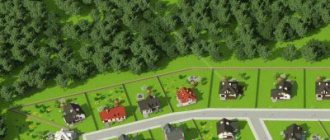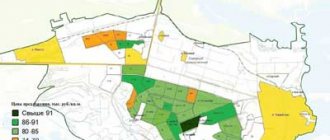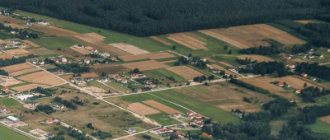Investments in land plots for construction are the most reliable option for investing money.
Such land does not lose its consumer properties, and with the development of the territory’s infrastructure, it increases in price .
The most popular options for locating private construction projects are plots with VRI “individual housing construction” and “LPH”.
Let's consider why they are so remarkable, what common features they have in common, and how they differ.
Definitions
individual housing construction
The type of permitted use of land individual housing construction allows the use of the site for construction purposes .
On such sites the law allows the construction of:
- private residential building;
- ancillary buildings.
However, there are a number of restrictions that must be followed :
- the number of storeys of the house should not exceed three tiers;
- the area of the building is limited by urban planning standards;
- the house is designed to accommodate one family;
- outbuildings are located maintaining the recommended distances from other objects.
It is prohibited to use objects located on individual housing construction lands for commercial purposes.
Read more about construction on individual housing construction plots in a separate article.
Private household plots
VRI LPH is assigned to land plots intended for growing agricultural products , breeding livestock and poultry for the family’s own needs.
In practice, such plots are separated from the lands of settlements, as well as agricultural lands.
Plots within the boundaries of settlements are called household plots; agricultural plots for private household plots are called field plots.
The categories of land on which plots for private plots are located impose a number of restrictions on the options for using the plots .
Household lands are used for activities such as:
- setting up a vegetable garden;
- construction of a residential building;
- placement of stables and sheds for domestic animals and poultry.
Field lands are suitable exclusively for agricultural production . The construction of permanent buildings on these sites is prohibited.
To realize such intentions, lawyers advise changing the VRI of the land to another that allows construction work to be carried out on the site.
Read more about the use of private plots of land in the feature article.
The difference between individual housing construction and private household plots
The difference between private household plots and individual housing construction is very significant. Before buying one or another plot, you need to evaluate the pros and cons of both solutions.
| Criterion | Private household plots | individual housing construction |
| Purpose | Growing agricultural products for personal needs | Construction of a residential building and ancillary buildings |
| Registration | Possible only if private household plot is located within the city | Possible by default if the house meets the “residential” criteria |
| Communications | Connection is at your own expense | Connection is carried out by local authorities |
| Home construction | Permitted only if private household plot is located within the city limits | Necessarily |
| Commercial detail | Prohibited | Prohibited |
| Taxation | The rate is 0.3% of the cadastral value | The rate is 1.5% of the cadastral value |
| Purchase terms | Purchase only | Inheritance, transfer under a gift agreement, purchase, purchase using maternal or military capital, mortgage |
| Infrastructure | Not available, partially available | Corresponds to the level of the settlement |
Both private household plots and individual housing construction are forms of ownership. The plot can be sold, donated, bequeathed, given for free use, or rented out. But at the same time, the cost of ILI is by default higher than that of private household plots, even with a similar development or use.
Main differences
The land plots considered by us have some features that influence the practice of their use.
Let's take a closer look at how individual housing construction land differs from private household plots.
Advantages and disadvantages
For ease of comparison, we summarize the main characteristics of land plots in the form of a table.
| Comparative category | individual housing construction | Private household plots | Notes |
| Land category | lands of settlements | lands of settlements, agricultural lands | |
| Main purpose of use | construction of personal housing | growing fruits and vegetables | |
| Valid Use Cases | construction of outbuildings, gardening activities | housing construction*, construction of ancillary buildings. | *exclusively on private plots |
| The need to obtain permits | Yes | Yes, with the end of the period of legislative permission for simplified registration of land and objects located on it* | *until March 2021, a residential building can be legalized by presenting a title document for the land. |
| Availability of utility and engineering infrastructure | Yes | not always | |
| Legal sale of surplus agricultural products | No | Yes | |
| Possibility of registration at the place of residence | Yes | Yes | |
| Limit size of plot | 0.03-0.3 ha* | 0.5 ha* | *regulated by local authorities |
| Land tax rate | high | low | |
| Cadastral value | * | * | *depends on the degree of infrastructure development of the territory, the presence of nearby social and cultural facilities, and the agricultural value of the land |
Conducting construction on the lands of private household plots that do not have convenient access roads or the necessary utilities brings additional costs, and therefore leads to a general increase in the cost of construction work .
Features of field sites
The development of field sites has significant difficulties.
Law No. 112-FZ “On personal subsidiary plots” directly prohibits the construction of buildings and structures in such territories .
But it does not say anything about the structures necessary for agricultural activities.
Such objects usually meet the following criteria:
- are temporary;
- have no foundation;
- They are a collapsible structure that allows you to easily move the object to another location.
The construction of structures on field sites must be legally justified , only in this case a permit for construction work will be issued to the developer.
A set of agricultural works may require the construction of the following structures:
- objects providing irrigation of agricultural crops - wells, ponds, various hydraulic structures, water towers;
- greenhouses equipped with a lighting and heating system;
- utility rooms for storing equipment;
- box for storing and repairing vehicles;
- toilet;
- household premises for the life support of people involved in conducting economic work on the site - a place for rest, eating, protection from bad weather conditions;
- a structure for keeping a guard dog;
- various sheds and corrals providing the possibility of raising livestock;
- facilities for the production of mushroom products.
It is prohibited to erect structures intended for storing agricultural products in field areas .
Financial aspect of use
Citizens of the Russian Federation are required to pay mandatory fees to the budget related to the ownership of real estate. Such payments include land tax.
The tax base for the tax is the cadastral value of the land . Traditionally, the tax rate for individual housing construction land is high, while the ownership of private household plot land is paid symbolically.
A land plot with VRI individual housing construction has its own benefits from the point of view of Tax legislation. It is during its purchase and sale, as well as a residential building located on its territory, that the state provides a tax deduction for personal income tax in the maximum amount of 260 thousand rubles.
To receive this amount, a number of conditions must be met:
- The cost of the property being sold (purchased) is greater than or equal to 2 million rubles.
- Transaction date: after January 1, 2009.
- Possession of property for more than three years.
- Official earnings.
On both types of plots it is possible to conduct economic activities involving the cultivation of vegetables and fruits and berries .
It is also possible to raise livestock on a plot with VRI private household plots.
Surplus produced goods can be sold by citizens at markets and weekend fairs.
Revenue from the sale of products obtained from private plots is not subject to taxation, provided that it was produced without the involvement of hired workers, and the size of the plot does not exceed the maximum established size.
To conduct agricultural activities on a private plot, registration of a citizen as an individual entrepreneur is not required .
Plots of individual housing construction are accepted by banks as collateral when applying for a mortgage loan. Land for private household plots is not used as collateral for a loan.
The cadastral value of individual housing construction plots is higher than similar plots with VRI private household plots. The reason is the possibility of free connection of individual housing construction of lands to the necessary communications .
In addition, the cost is affected by their location in close proximity to various social and cultural facilities, as well as the possibility of participation in government programs for landscaping. The high cadastral value creates a high selling price for individual housing construction plots.
The less costly option from an economic point of view of building a house on the lands of private household plots can result in large costs for connecting communications, as well as paying for energy resources and utilities.
DNP
A dacha non-profit partnership is a type of land that allows you to build a country house within the framework of a dacha partnership. It is organized to facilitate the maintenance of common lands, and it can be created from scratch. Now this category of land no longer exists; it is recorded in old documents.
“DNP status gives the right to organize water supply and gas supply in the village. Unlike SNT, land in the DNP category allows the owner to erect any structure: even a garden or residential building, a bathhouse or a barn. DNP sites can be located both outside populated areas and inside them. In the latter case, it becomes possible to recognize a private house as residential and register in it in accordance with the resolution of the Constitutional Court of the Russian Federation of April 14, 2008 No. 7-P,” said Sergei Bondar.
Change of VRI
Most often, there is a need to change the VRI from private household plots to individual construction. This is due to the fact that individual housing construction provides the owner with many more opportunities when arranging the plot.
People resort to changing the type of permitted use from individual housing construction to private plots if they want to organize a mini-farm or reduce the burden of the tax burden on the family.
Changing the VRI is possible for areas related to settlement lands.
The procedure is carried out by municipal authorities and takes one and a half months . The applicant must attach the following documents to the application:
- title documents for the land plot;
- cadastral passport for the land and real estate located on it;
- written confirmation of the consent of the co-owners of the land, as well as the owners of neighboring plots.
The body considering the application has the right to request other documents listed in the administrative regulations for the provision of the relevant municipal service.
Read more about changing the land VRI in the feature article.
Legislation
According to the legislation of the Russian Federation, all state lands are classified into categories, depending on the possibilities for the safe and efficient exploitation of certain territories. For each land category, a list of types of permitted use (hereinafter referred to as ARU) of land plots is determined by law.
Citizens of the Russian Federation can own plots of land classified as agricultural land (hereinafter referred to as Agricultural Land) and land in populated areas. Depending on the above categories, land plots must be exploited in accordance with the VRI assigned to them.
Inappropriate use of land plots threatens owners with various sanctions measures from authorized government bodies - from a single fine to confiscation of a land plot.
Getting permission
A building permit is not required when registering the right to a house, but it is still better to obtain one. The Town Planning Code of the Russian Federation (Parts 1 and 2 of Article 51) still provides for the need to build only with a construction permit, and the Code of Administrative Offenses (Part 1 of Article 9.5) establishes liability for the construction of a capital construction project without permission.
A violator, an individual, is subject to a fine of 2 to 5 thousand rubles, and such a fine can be imposed repeatedly throughout the entire construction period.
To obtain a construction permit, an application for a permit and three documents accompanying it are submitted to the local administration:
- Title document for land.
- The urban planning plan of the site, you must first obtain it from the same administration by writing an application for issue; the administration collects the documents for registration independently; the urban planning plan is issued free of charge within thirty days from the date of submission of the application.
- A planning organization diagram, which is prepared by the developer to the best of his ability - usually the proposed development scheme is drawn with a pen on a copy of the cadastral plan.
If these 3 documents are available, a building permit is issued no later than 10 days after submitting the application.
Will it be possible to change the status of the site later?
Transfer of land from one category to another is possible . To do this, you need to submit a corresponding application to the local authorities and collect the necessary documents:
- plan;
- conclusion of geological examination;
- certificate of the cost of the plot, etc.
This process is quite lengthy, on average it can take from six months to a year.
Thus, each category of land plots has its own characteristics, advantages and disadvantages . The greatest differences are related to the intended purpose of the land.
Our website contains other useful materials on similar topics.
- Types of permitted land use:
- Basic.
- Conditionally permitted.
- Auxiliary.
- Changing the type of permitted use.
- By whom and how is VRI installed?
- Why do you need a VRI classifier and how to use it?
- Differences between peasant farms and private household plots.
- The difference between SNT and individual housing construction.
Minimum/maximum size
A plot of private household plots can be provided as a property or purchased.
If the land is issued by local governments or the state, then the size of the plot (minimum and maximum) will be limited by the standards established by the local governments. Thus, in Vladimir, a plot of land from 0.04 hectares to 0.15 hectares can be provided. In the city of Cheboksary - from 1200 to 1500 sq. m. m.
One family (one private household plot) may own (or otherwise have) a limited amount of land, as a general rule - 0.5 hectares. Regional legislation may increase this number, but not more than 5 times. In the Vladimir region, a private plot can be up to 2.5 hectares in size, in the Chuvash Republic it should not be more than one hectare.








